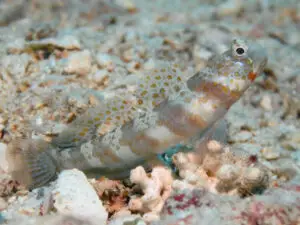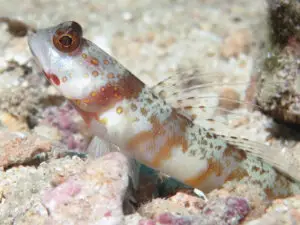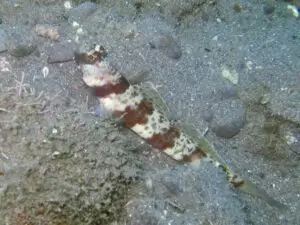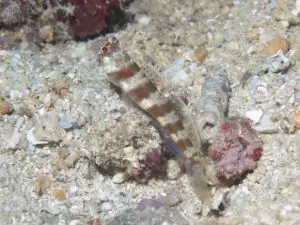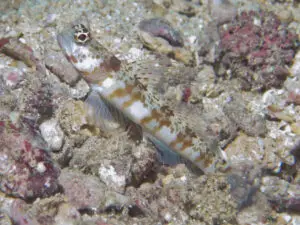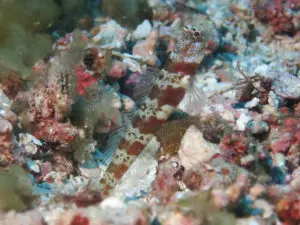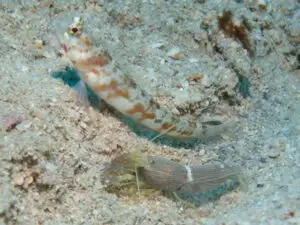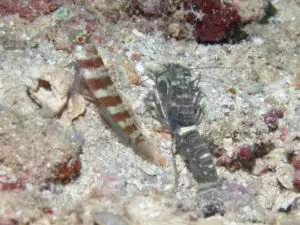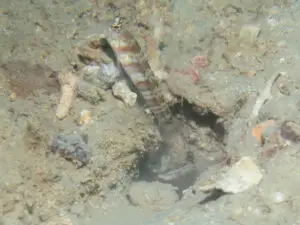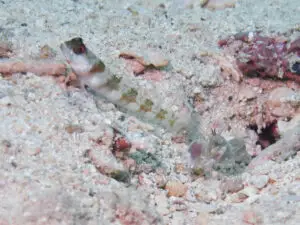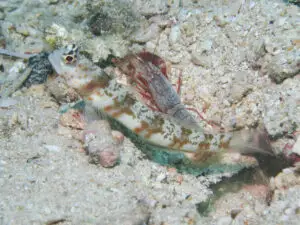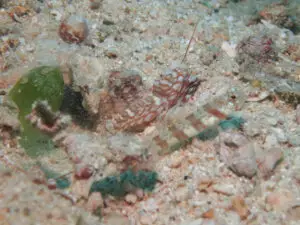Broadbanded Shrimpgoby
Amblyeleotris periophthalma

Broadbanded Shrimpgoby
Amblyeleotris periophthalma
(Bleeker, 1853)
Description
Body design
This is a medium-sized goby, around 11 cm in length, tan in colour with six broad brown bars, often with a paler centre and a short horizontal branch in the midline of the central four. Between these are conspicuous irregular brown blotches. The head is decorated with dark-edged orange spots and a pair of red patches on each side at the angle of the mouth.
Fin design
Both dorsal fins are decorated with dark-edged brown spots. The pectoral, pelvic and caudal fins are translucent with faint red streaking. The anal fin is blue-green at the base with a purple mid-portion line between this and the blue margin.
There are two patterns of the first dorsal fin, one rectangular, the other triangular with long rays. These may be sexual differences.
Diagnostic features
The brown blotches in the pale zones between the broad pale-centred body bands are obvious from a distance.
Influence of habitat On darker sand the colour of the pigmented areas is intensified and more reliable Darker pigmented individuals have dark facial lines and sometimes a dark face. The species is variable in appearance.
Similar species
This is a distinctive goby. It could be confused with A. wheeleri which looks much darker.
Taxonomy
Other common names: Blotched Shrimp Goby, Periophthalma Shrimpgoby, Slender Shrimp Goby.
Natural History
Habitat
Variable depth and habitat 5 to 35 metres. From the outer reef front to the sheltered fringing reef.
May be found on flat rubble, sand between scattered small coral rock outcrops on patch reefs, and also on black sand slopes.
Though this is the usual habitat we have also seen them at 30 m on sand with small coral rock fragments in parallel rows on the seaward side of Ribbon Reef #3. The Yellow Pyjama Shrimp is the partner in this habitat.
Behaviour
These shrimpgobies may react aggressively to the approach by another fish too close to the burrow. On the other hand, a shrimpgoby pair that happens to have its burrow nearby is accepted and they often live amicably near other species, in this case, A periophthalma and A steinitzi.
The shrimpgoby props itself up on rocks to keep a good lookout. We usually only see a single individual at the entrance although occasionally there are two.
Distribution
Published distribution: Red Sea, Persian Gulf, Zanzibar, and Mauritius east to the Caroline Islands and Samoa Islands; New Caledonia, Ryukyu Islands. Australia: Dampier Archipelago to the Solitary Islands.
Our records: Indonesia, Solomon Islands, Vanuatu, Papua New Guinea and Australia: Lizard Island. South Direction Island, Seaward side of Ribbon Reef 3, Ribbon Reef 10, Michaelmas Cay, Low Isles, Whitsunday outer reefs and Keppel Bay.
Associated Shrimp species
Associated Shrimps (six shrimps)
Usual association
Brown Pyjama Snapping Shrimp, Alpheus ochrostriatus
Dark Marbled Snapping Shrimp, Alpheus macellarius
Grey Snapping Shrimp, Alpheus species 5
Red Pyjama Snapping Shrimp, Alpheus ochrostriatus
Red Snapping Shrimp, Alpheus species 9
Tiger Snapping Shrimp, Alpheus bellulus
The Brown Pyjama Snapping Shrimp and the Tiger Snapping Shrimp are the usual hosts. The other species are seen occasionally.

